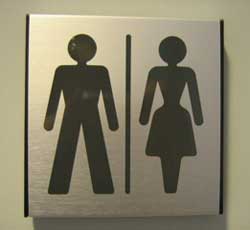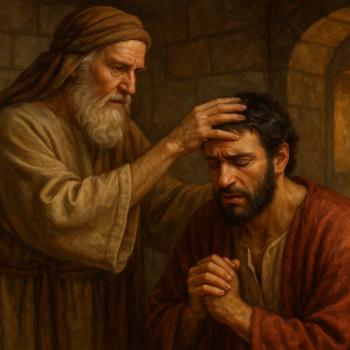 Gender polarity has acquired a bad reputation in some Pagan and magickal circles. In the Craft ritual of the Great Rite, a blade is inserted into a full cup with the words, “As the athame is to the male, so the cup is to the female” -- or, if the rite is not being performed “in token,” the priestess and priest may engage in an act of heterosexual intercourse. The ritual recalls and participates in the universe’s moment of creation, where (in kabbalistic terms) ultimate Force plunges into ultimate Form and triggers the birth of Being itself. It’s beautiful imagery, and a beautiful ritual -- unless, of course, you’re queer.
Gender polarity has acquired a bad reputation in some Pagan and magickal circles. In the Craft ritual of the Great Rite, a blade is inserted into a full cup with the words, “As the athame is to the male, so the cup is to the female” -- or, if the rite is not being performed “in token,” the priestess and priest may engage in an act of heterosexual intercourse. The ritual recalls and participates in the universe’s moment of creation, where (in kabbalistic terms) ultimate Force plunges into ultimate Form and triggers the birth of Being itself. It’s beautiful imagery, and a beautiful ritual -- unless, of course, you’re queer.
I'm overgeneralizing here -- there are gay, lesbian, and transgender Pagans practicing traditional Craft or ceremonial magick, and for some, this imagery works well. Usually, GLBT practitioners of these traditions understand the universal Feminine and universal Masculine as psychological aspects of every human being, regardless of their sexual orientation, biological makeup, or gender identity. But for some practitioners, gender polarity in ritual excludes and marginalizes those for whom male-female pairings are unappealing or who consider heterosexual intercourse to be simply one acceptable menu item amongst a smorgasbord of sexual choices. Those who engage in gender-polarized ritual as a central practice may correctly point out that (some recent miracles of modern medicine aside) we are all the result of acts of heterosexual sex. But for me, this overlooks the queer diversity of Mama Nature, who for millions of years has been content to let at least some of her organisms reproduce by a variety of asexual methods.
In my mind, to fixedly equate the penis with universal Force and the vagina with universal Form is a case of mistaking the map for the territory (or, as I'll suggest later, *a* map). As many recent gender studies theorists have pointed out, the active, solar, intellectual, word-centered "phallus" that we associate with so many troublesome and oppressive social constructs in Western culture is not actually the same as the rather delicate, fleshy instrument that hangs between men's legs. Indeed, the amount of pressure placed upon that instrument by the cultural construct known as the "phallus" is nigh overwhelming. Nor should every individual woman's personal vagina and uterus be necessarily identified with the Universal Womb of the Goddess. Certainly for those women who find such an identification empowering, I would encourage them to embrace it, but not every woman finds it helpful to have her uterus spoken of in terms of Divine Fertility when she may not want to immediately, or ever, have children. The identification of body parts with enormous theological concepts is not necessarily a liberating practice for individuals, nor is it one that necessarily fits their life experience.
Because of the strength of these symbols in contemporary Paganism, polarity-based magick has frequently been accused of being gender essentialist. In other words, such magickal systems are seen as having rigid ideas of what masculinity and femininity are, and then putting pressure on practitioners to live up to those ideals. In the process, practitioners' poor, unassuming genitalia acquire an enormous amount of symbolic weight. Those who prefer to use their genitals in a culturally non-mainstream fashion, understandably, have taken issue to the idea that because of their sexuality, they cannot participate in rituals celebrating the creative forces of the universe as well as their heterosexual counterparts can. And so, gender-polarized magick has acquired a reputation for homophobia, as well as for a bit of stodginess and bad taste.
Long ago and far away, I left a British Traditional Wiccan coven that was attempting to become more "traditional" through, among other things, putting greater emphasis on the nature of members' plumbing. Transfolk were welcome only as long as they had had surgery to make their bodies match their chosen gender, and initiates were prohibited from drawing down deities of the opposite sex until they had attained the second degree (apparently differently-gendered energy was thought to be "confusing"). At the time, I was entirely skeptical of the notion of polarity, preferring Starhawk's idea (as she articulates it in the second and third editions of The Spiral Dance) that the energy of the universe does not move fundamentally between any two poles, but instead is a complex dance among many beings and forces. Reflecting on her evolving understanding of the myth of the Star Goddess, as told by Feri tradition founder Victor Anderson, she writes:
[W]hat we call "female" and "male" are sort of arbitrary designations of points along a continuum, stations on a wheel. Polarity, desire, attraction might arise between and among any combination of them. Polarity is not merely a straight line between two poles; it is a net of forces between a multiplicity of nodes in a sphere, each of which contains its own opposite. [. . . ]




